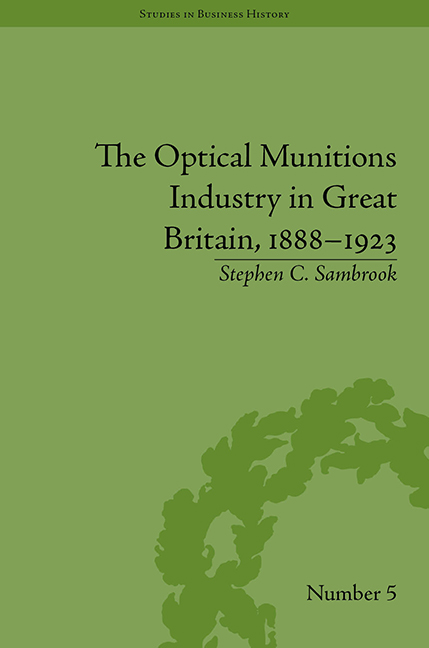Book contents
- Frontmatter
- CONTENTS
- Preface and Acknowledgements
- List of Figures and Tables
- List of Technical Terms
- Introduction
- 1 The Emergence of the Industry, 1888–99
- 2 The Growth in Importance from the Boer War to 1906
- 3 Expansion and Consolidation, 1907–14
- 4 The Impact of War, August 1914 to mid-1915
- 5 Industrial Mobilization: The Ministry of Munitions and its Relationship with the Industry
- 6 The Industry's Wartime, 1915–18
- 7 Industrial Demobilization and Implosion, 1919
- 8 Adaption and Survival, 1919–23
- Conclusion
- Notes
- Works Cited
- Index
4 - The Impact of War, August 1914 to mid-1915
- Frontmatter
- CONTENTS
- Preface and Acknowledgements
- List of Figures and Tables
- List of Technical Terms
- Introduction
- 1 The Emergence of the Industry, 1888–99
- 2 The Growth in Importance from the Boer War to 1906
- 3 Expansion and Consolidation, 1907–14
- 4 The Impact of War, August 1914 to mid-1915
- 5 Industrial Mobilization: The Ministry of Munitions and its Relationship with the Industry
- 6 The Industry's Wartime, 1915–18
- 7 Industrial Demobilization and Implosion, 1919
- 8 Adaption and Survival, 1919–23
- Conclusion
- Notes
- Works Cited
- Index
Summary
The optical munitions makers, like almost all of British industry, were unprepared for the demands of a major war and encountered a variety of problems in responding to the growing demands made upon them between August 1914 and the early summer of 1915. Some of these difficulties were outside the industry's own control, but others resulted from the overall structure of optical instrument making within which most of the established munitions contractors lived. The principal difficulty was the unanticipated, exponentially increasing demand from the British Army that was expanding on an unprecedented scale and which had not yet been fully equipped with optical apparatus before the war. In the first ten months of the conflict, the War Office failed not only to quantify its own optical requirements accurately, but also neglected to concentrate the orders it did place on the makers who were best suited to deal with them. There was an inability to recognize, let alone come to terms with, the strengths and limitations of both the general and specialized optical sectors of the industry. Its strengths were either ignored or disregarded during 1914 and early 1915, and the ensuing shortcomings in deliveries have been read as signifying a chronic systemic weakness in the industry, particularly in that it had failed to keep up with both its French and German counterparts.
- Type
- Chapter
- Information
- The Optical Munitions Industry in Great Britain, 1888–1923 , pp. 85 - 106Publisher: Pickering & ChattoFirst published in: 2014



